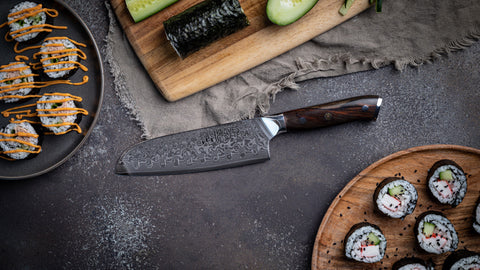A question we commonly get asked is what is a santoku knife and why is it so popular? This previously unknown knife has gained plenty of fans over the years and is now considered one of the most sought after knives in the market.
So what is the Santoku knife and where did it originate? Read on as we give an explanation.
Santoku Knife Origins
The Santoku Knife, as you may have guessed from its name, originates from Japan. They first appeared in the years following World War 2 and were created as an alternative to the traditional vegetable cleaver that resided in many Japanese kitchens at the time.
While it was similar in height and possessed a straight edge like the vegetable cleavers at the time, santoku knives contained a different tip that curved down towards the edge of the knife to form a point approaching 60 degrees.
Santoku Knife Meaning
The name Santoku is thought to translate to ‘three virtues’ and this name is largely thought to relate to its versatility and the number of tasks it can perform. It is believed the ‘three virtues’ are related to the Santoku knife’s extreme effectiveness when it comes to slicing, chopping and dicing.
Popularity Explosion
Shortly following its adoption into most Japanese kitchens, the santoku knife quickly rose through the ranks to become the most popular kitchen knife across Japan. This is largely thanks to its tremendous versatility and the ability to perform such a wide range of tasks to such a high standard - whether confronting fish, vegetables or meat.
While immensely popular in Japan, it took until the 1980s for the explosion of purchasing to reach a global level, as global news became easier, travel accelerated and word of this miraculous knife caught the attention of professional and amateur cooks worldwide. It is now a global superstar and it is little wonder why considering how effective it is irrespective of the user’s cooking level.
The Brilliant Design
The geometry of the Santoku blade features the easily identifiable sheep’s foot tip design. This design results in a linear cut due to the very minimal clearance above the cutting plane when the blade is positioned from heel to tip. While the Santoku knife can be used in a standard rocking motion, when this occurs there is very little contact with the surface due to the extreme angle of the tip. This is why the best practice when using the Santoku knife is to perform a single downward cut rather than the rocking motion more common in Western society.
The lightweight, compact design of the Santoku knife leads to ridiculous ease of use. Typically, the Santoku knife is shorter, lighter, thinner and contains more premium steel (such as Damascus) than the alternatives.
Typically, the length of a santoku knife will sit somewhere between 6 and 7 inches, which tends to be less than the 8 inches that are common with a chef’s knife.
The angle of the blade is usually more extreme than most conventional kitchen knives with a 12 to 15 degree shoulder compared to the bilateral 20 degree shoulder of a conventional kitchen knife.
What to keep your eye on when shopping for a Santoku Knife
Ideally, there is really only one crucial characteristic that you need to consider when looking for a Santoku knife to add to your kitchen. The quality of the steel is what sets apart one santoku knife from the next.
While most Santoku knives are made from stainless steel, the quality of this steel can differ greatly. This is where obtaining a Santoku Knife that is made from a high-quality steel such as Damascus can prove incredibly beneficial. This generally ensures that you are not only purchasing a knife that is extremely versatile but one that is long-lasting and of the highest quality.
Of course, it would be amiss of us not to mention another crucial factor for most shoppers: price. Santoku knives are going to be your ‘ go-to’ knife for many kitchen chores so it is understandable to fork out a little more for this vital member of your knife collection. However, thankfully due to the ample competition in the marketplace, you can get your hands on a high-quality, Damascus steel santoku knife for under $150.
Rest assured, it will be money well spent!
In Summary
- The Santoku knife originated in Japan and quickly rose in popularity to become the first choice throughout the Japanese region
- Santoku knives are similar to the Western chef knife however are sleeker in design, lighter and smaller
- When purchasing a Santoku knife it is important to look for a product that is made from a high-quality steel like Damascus
- Price should be a factor but in regards to the Santoku Knife - you get what you pay for. Considering it is going to be regularly used, you should be willing to part with a little more money than you typically would for a conventional kitchen knife
